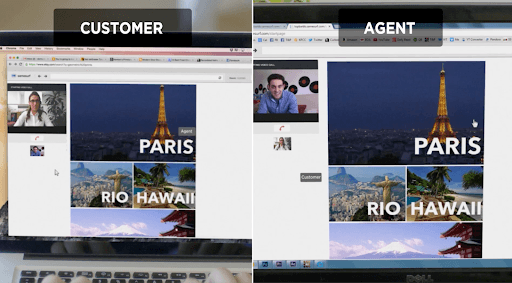How Samesurf’s Architecture Empowers Long-Term Agentic AI Persistence
October 22, 2025

Samesurf is the inventor of modern co-browsing and a pioneer in the development of core systems for Agentic AI.
Creating truly autonomous AI agents that are capable of managing complex, multi-day workflows presents a fundamental challenge: the stateless nature of Large Language Models. LLMs process each prompt independently while disregarding prior history, task progress, and user-specific details unless the entire context is repeatedly re-injected.
Systems that require persistence must engage in “context stuffing,” which feeds vast amounts of historical data back into the model for every step. This approach creates a steep economic and operational bottleneck, as the cost of maintaining long-term workflows scales linearly or even exponentially.
Simply increasing the LLM’s context window does not fully solve the problem. The solution lies beyond the LLM itself: persistence must be managed architecturally, with intelligent context storage and retrieval to maintain a high signal-to-noise ratio, control costs, and ensure consistent execution. Samesurf’s architecture addresses this challenge by providing the external framework that is necessary for long-term agentic AI persistence.
The Agentic Mandate and Persistence for Multi-Session Workflows
True Agentic AI stands apart from basic automation tools or chatbots through its autonomy and its ability to pursue complex goals independently by combining reasoning, planning, memory, and adaptation. These capabilities are essential for reliable performance in dynamic digital environments. Without persistent memory, an AI system is confined to short-term, transactional interactions.
Persistence provides the architectural foundation that allows an agent to function as a dependable collaborative partner. Many enterprise tasks, such as customer onboarding, claims processing, technical support, and HR workflow, extend well across multiple sessions or days. These processes rely on sequential orchestration, where each stage depends on the state of the previous step, and output quality improves through progressive refinement.
If the agent loses session state, including completed form fields, met dependencies, or navigation context, the workflow fails and requires costly restarts. Persistence ensures the agent maintains contextual awareness across time, which allows it to resume complex workflows exactly where it paused, whether minutes or days later. Samesurf’s architecture delivers the framework necessary to achieve this level of multi-session reliability.
The Critical Difference Between RAG and Memory
Two primary architectural approaches have emerged to address the stateless nature of LLMs: Retrieval-Augmented Generation (RAG) and dedicated memory systems. RAG provides factual grounding by allowing access to live external information without retraining. This method functions as a dynamic retrieval layer, often querying a vector database at runtime, and resembles a sophisticated search engine.
RAG differs fundamentally from true memory because the focus lies on retrieval rather than state management. The system cannot manage the lifecycle of dynamic facts and prioritizes semantic similarity over temporal relevance. This creates gaps where recency, contradictions, or evolving knowledge are not properly resolved.
For example, if an AI agent is told “I live in Cupertino” in one session and “I moved to San Francisco” in a later session, a RAG system may retrieve both facts if the semantic query matches. The system cannot resolve temporal conflicts or update knowledge in context. RAG delivers static or slowly changing information such as policy documents, while true agent memory captures the operational reality of ongoing workflows such as the precise checkpoint in a multi-step form or a user’s updated preferences. Long-term agentic persistence requires a mechanism that can evolve, update facts, and discard outdated information thereby necessitating dedicated memory logic layered above the retrieval engine.
True memory extends the capabilities of RAG by allowing agents to learn, adapt, and maintain continuity across sessions. The agent can preserve a thread of experience similar to human cognition. Persistent memory relies on systems that go beyond text retrieval, often storing knowledge in graph structures or specialized embeddings so that agents can instantly recall facts, past interactions, and tool usage history, regardless of time elapsed.
Complex, multi-step workflows demand a temporal anchor – a complete time-stamped record of actions and decisions that are managed externally to ensure reliable resumption of execution. Advanced architectures, including Memory Networks and differentiable memory modules integrated into language models, confirm that true persistence cannot rely on retrieval alone. Achieving long-term agentic AI persistence requires a dedicated memory system capable of evolving with the workflow and preserving context across sessions.
Samesurf’s Solution for Agentic AI Persistence
Samesurf addresses the challenge of agentic AI persistence by containing the agent’s actions within a secure, controlled cloud environment. The platform operates directly in the browser, sharing only the relevant web content and avoiding downloads or plugins that could expose sensitive system elements. This secure sandbox captures the operational state as a core function and enables AI agents to maintain context while protecting privacy and compliance.
High-fidelity state capture is essential when agents navigate complex web interfaces or dynamic content. Text-based memory systems cannot perceive visual cues and often fail with changing UIs or multi-step workflows. Samesurf’s architecture preserves both visual and operational context. AI-enabled agents can simulate human browsing behavior, including navigation and form completion, entirely within the secure environment. When a session pauses, whether due to multi-day workflows or human approval, Samesurf’s platform preserves the complete UI state, navigation history, form field progress, and agent actions. This persistent record transforms agent execution from a stateless model into a resumable cloud process, thereby allowing workflows to continue precisely where they left off while maintaining integrity.
Multi-agent collaboration often drives complex enterprise workflows. To address ephemeral memory limitations, Samesurf leverages the Secure Agent Memory Exchange Protocol (SAMEP) which enables secure, semantically searchable memory sharing between agents in workflows that span departments, such as capturing user intent in sales, handing off calculations to finance, and validating actions through compliance. By transforming memory into a shared institutional asset rather than an isolated feature of individual agents, Samesurf empowers scalable, persistent agentic AI across HR, IT, Customer Support, and other functions.
Enabling True Agentic AI Persistence
AI-enabled agents operating in high-stakes environments require rigorous human oversight and guaranteed accountability. Samesurf integrates humans into the loop by linking persistence with control mechanisms. Patented innovations enable in-page control passing by allowing an operator to monitor a session and seamlessly take over the simulated browsing activity at any moment.
Saving and restoring the precise operational state is essential for enterprise reliability. When an AI agent encounters an anomaly, critical error, or situation requiring manual expertise, the system checkpoints the state. The human intervenes to correct the path or make decisions, then returns control to the agent without losing context or progress. In sectors such as finance and insurance, persistent state capture provides the high-fidelity record necessary for comprehensive auditing. Persistence thus functions as a risk mitigation tool and ensures that autonomous action remains accountable.
Samesurf’s cloud platform is built to handle complex, multi-day enterprise workflows across verticals such as healthcare, finance, and insurance. These processes often involve multiple sequential steps where loss of state is not an option. The persistence mechanism ensures that work completed in one session, such as navigating benefits portals, filling lengthy forms, or performing collaborative debugging, is preserved. Agents resume tasks precisely where they paused, ultimately transforming digital interactions into continuous, durable operations that retain the value of previous steps.
Data security and regulatory compliance further emphasize the need for external, persistent state management. Unlike retrieval-augmented systems, which store data in secure environments, Samesurf manages the entire session state, including sensitive information, visual context, and interaction history, within its compliant cloud environment. By providing features such as HIPAA-compliant content sharing and automated redaction of sensitive elements, the platform ensures session state is captured, stored, and restored securely. Persistence becomes inseparable from security, which reduces the risks of data exposure during extended autonomous operations.
The Future of Agent-Driven Enterprise Workflows with Samesurf
Samesurf’s persistent architecture delivers immediate operational cost efficiency by externalizing the high-fidelity session state, which includes visual context, interaction history, and operational checkpoints, outside of the LLM’s limited context window. This approach dramatically reduces the volume of redundant data processed with each prompt.
The external memory layer acts as a precise context filter. Instead of forcing the LLM to process the entirety of prior interactions, the system injects only the relevant data or summarized information needed for the next logical step. This intelligent context management preserves a high signal-to-noise ratio, eliminates performance degradation caused by excessively long context windows, and minimizes the economic burden associated with repetitive token processing.
The move from ephemeral, retrieval-based systems to persistent, adaptive memory represents a fundamental shift in AI deployment. Agents built on this architecture gain the ability to learn continuously and personalize experiences across sessions using a cumulative interaction history. This transforms interactions from isolated transactional queries into seamless, intelligent workflows for end users.
Architectural protocols like SAMEP ensure that persistence is not confined to individual interactions. Knowledge is retained and shared across agents, which creates a continually evolving repository of institutional memory. Collective experience and refined task completions accumulate over time and improve the overall efficiency and capabilities of the organization’s agent workforce.
The challenge of AI memory is not a matter of model scale but of architectural design. True long-term agentic AI persistence requires an external state management layer that is high-fidelity, comprehensive, and inherently secure. Samesurf provides this solution through its patented secure cloud browsing platform, which delivers persistent visual and operational context while maintaining enterprise-grade security. By combining secure state capture, the SAMEP protocol for inter-agent knowledge exchange, and integrated human-in-the-loop controls, Samesurf transforms agentic AI from a fragile, short-lived process into a practical, scalable, and economically viable solution for managing complex enterprise workflows.
Visit samesurf.com to learn more or go to https://www.samesurf.com/request-demo to request a demo today.


